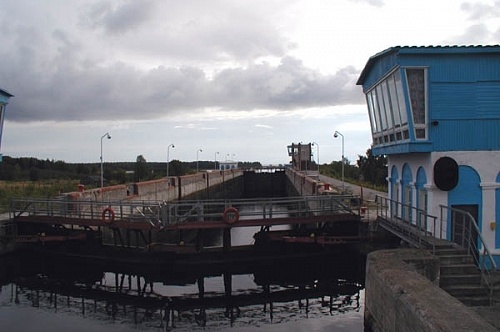The waterway from the central part of the country to the north was well known in the XVI - XVII centuries to the citizens of Moscow, Kiev, Novgorod and almost to every Russian. The "Path of pilgrims" went through the cities of Povenets and Sumsky Posad to the sanctuaries of the Solovetsky monastery. In the XIX century people thought of the necessity of building a canal along this route. This problem was took up by State Duma, but the canal was built only in the Soviet time.
On February 18, 1931 the Council of Labor and Defense of the USSR decided to start one more accelerated building site – the construction of the Belomorsko-Baltic waterway. That was an immense construction: more than a hundred of complex hydroengineering objects had been built in a year and 9 months with the minimum use of iron and cement. More than a hundred of thousands of prisoners built the canal and were released.
The whole length of the waterway is 227 kilometers, 48 of them make an artificial canal. The system consists of 19 locks, 51 dams, 12 floodgates and other hydroengeneering objects. The conventional direction of the Belomoro-Baltic canal is from the Onego lake to the White Sea. Since the average depth of the channel is about 5 meters, it was not used for navigation till the 50-ies.
The canal starts not far from the city of Povenets in the Povenetskaja bay of the Onego lake. In the past this faraway northern village was the place of deportation. Nowadays Povenets is a large port. The southern, Onego slope of the Belomoro-Baltic canal is the steepest. There are 7 locks on it. The ships, which go from the Onego lake to the north, come up "Povenchanskaja" staircase for 70 meters. The slope to the White Sea is gentler. Twelve locks pull down the ship for 102 meters.
During the Civil war the southern part of the canal was totally destroyed. But in 1946 the canal was renovated and adapted for navigation of huge ships.
The construction of Belomorsko-Baltic canal and later the industrial complex of the same name gave birth to the cities of Belomorsk, Nadvoitsy, Segezha, Medvezhegorsk and a large forest land from the White sea to Onego lake.
The contribution of the Belomorsko-Baltic canal into the development of the national economy of the European North was awarded with the Honors of the Red Labours.
After the Volgo-Balt was built, all the inner waters of the European part of the country became connected into a single system.




